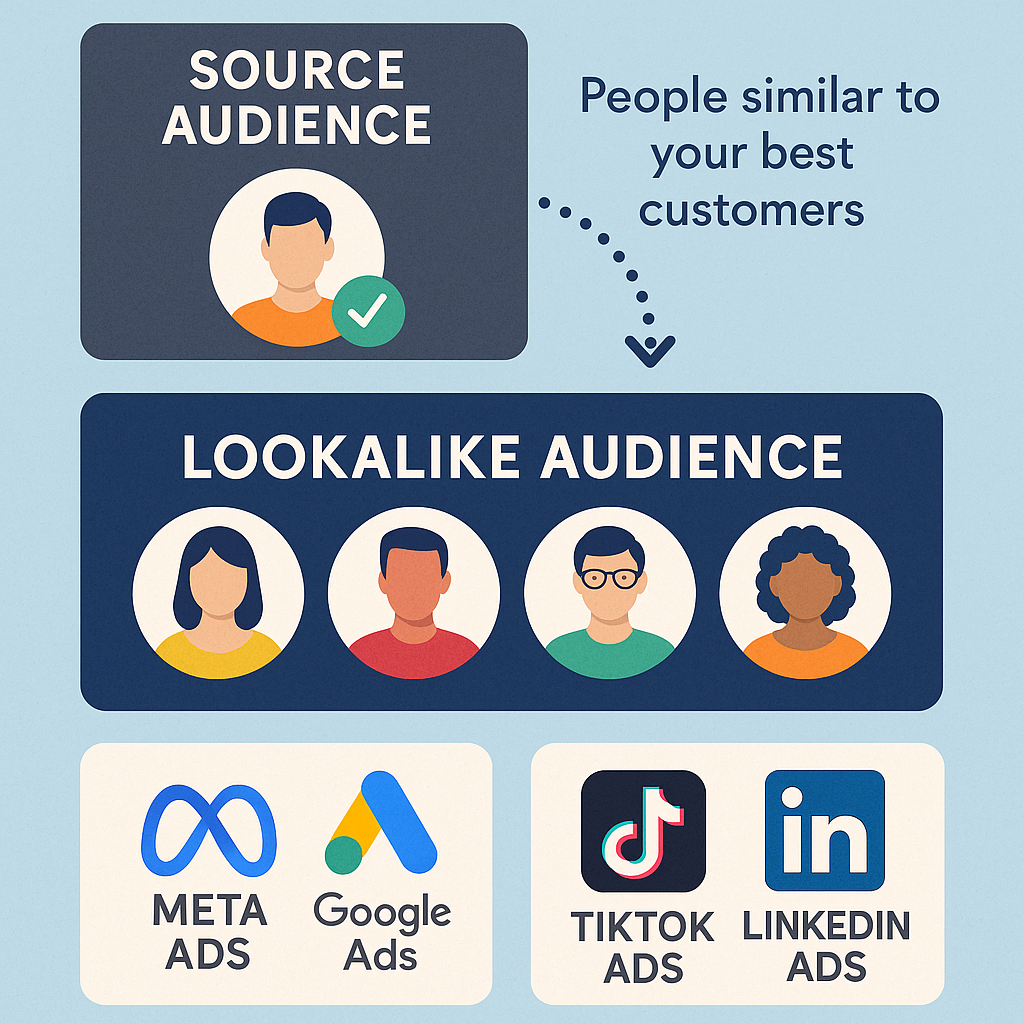One of the biggest challenges in traffic management is knowing how to scale campaigns without losing performance. Many ads work well in the beginning — but when you increase the budget or expand your reach, results drop.
That’s where lookalike audiences come in.
Lookalike audiences allow you to reach new people who behave like your best customers, giving you the power to scale with precision rather than guesswork.
In this article, you’ll learn how lookalike audiences work, how to create them on major platforms, and how to use them strategically to grow your results without wasting ad spend.
What Is a Lookalike Audience?
A lookalike audience is a group of people that an advertising platform identifies as similar to a source audience you provide. These users haven’t interacted with your business yet, but they share behaviors, interests, or characteristics with those who have.
The result? You’re advertising to a fresh audience that’s more likely to convert — because they resemble the people who already did.
Platforms That Offer Lookalike Audiences
✅ Meta Ads (Facebook & Instagram)
- Based on custom audiences (website visitors, video viewers, purchasers, etc.)
- You choose source audience and percentage size (1% = most similar, 10% = broader)
✅ Google Ads (Similar Segments)
- Automatically created based on remarketing lists (though being phased out and replaced by Optimized Targeting and Audience Signals)
✅ TikTok Ads
- Lookalike audiences based on events, engagement, or custom lists
✅ LinkedIn Ads
- “Lookalike Audiences” based on matched audiences (website, contact list, etc.)
Benefits of Using Lookalike Audiences
- Scalability: You can reach thousands or millions of new people similar to your top converters
- Higher ROI: Since the audience is pre-qualified by similarity, results often improve
- Automation: The algorithm does the heavy lifting in identifying who to target
- Easy to test: You can create multiple variations (e.g., 1% vs. 2% vs. 3%) to find your sweet spot
How to Create Lookalike Audiences on Meta (Step-by-Step)
Step 1: Build a High-Quality Source Audience
The better your source, the better your lookalike.
Best sources include:
- Purchasers (from Pixel data)
- Leads who filled out a form
- High-value customers (via uploaded CSV)
- Engaged video viewers
- Website visitors who spent 2+ minutes
💡 Ideal size: at least 100–1,000 people for best results.
Step 2: Go to Audience Manager
In Meta Business Suite:
- Click “Audiences”
- Select “Create Audience” → “Lookalike Audience”
Step 3: Choose Your Source + Location + Size
- Source: Your custom audience
- Location: Country or region you want to target
- Audience Size: 1% (closest match) to 10% (broader reach)
Start with 1%, then test wider audiences as you scale.
Step 4: Use in Your Campaigns
In the Ad Set level, choose your lookalike as the targeting option. You can combine it with interests or leave it broad.
Best Practices for Lookalike Audiences
🎯 1. Use High-Intent Source Audiences
The quality of your lookalike depends entirely on your source. Prioritize people who have already:
- Purchased
- Signed up
- Watched 75–100% of a video
- Spent time on your site
Avoid using cold audiences or random email lists as a source.
🎯 2. Segment and Test
Instead of creating just one lookalike, test several:
- 1% vs. 3% vs. 5%
- Lookalike from purchasers vs. leads
- Country-specific variations
This helps you find the sweet spot between reach and relevance.
🎯 3. Exclude Your Source Audience
Avoid overlap by excluding the custom audience used as your source from your lookalike campaigns. This ensures you’re reaching new users only.
🎯 4. Combine With Retargeting for Full Funnel
Use lookalikes for top-of-funnel awareness, then:
- Retarget viewers or site visitors
- Offer lead magnets or limited-time deals
- Use email marketing to nurture leads
A lookalike is just one step in your funnel — not the entire strategy.
When to Use Lookalike Audiences
Use lookalikes when:
- You’ve already generated leads or sales
- You want to scale your campaign without lowering ROAS
- You need fresh but qualified traffic
- Your interest targeting is too limited or saturated
- You want to expand into new countries or regions
Lookalike vs. Interest Targeting vs. Broad Targeting
| Strategy | Best For |
|---|---|
| Interest-Based | Starting out, small budgets |
| Lookalike | Scaling based on proven behavior |
| Broad Targeting | Large budgets + strong creative/testing |
💡 Tip: Once your pixel collects enough data, broad targeting with optimized conversion can outperform lookalikes — but lookalikes are still a powerful stepping stone.
Final Thoughts: Scale Smarter, Not Just Bigger
Lookalike audiences are one of the most efficient tools for scaling ad campaigns without throwing money away on unqualified traffic.
By leveraging your existing data, you let the algorithm find your next best customer — faster, cheaper, and with better results.
Use them wisely, test consistently, and combine with great creatives and offers — and you’ll have a scalable, repeatable system that grows your business or your client’s.
